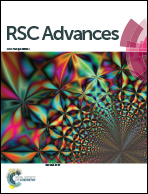PEDOT:PSS assisted preparation of a graphene/nickel cobalt oxide hybrid counter electrode to serve in efficient dye-sensitized solar cells
Abstract
Graphene/nickel cobalt oxide (Gr/NiCo2O4) hybrids with a nanostructure were prepared by the use of an in situ hydrothermal route, and applied as a counter electrode (CE) with poly(3,4-ethylenedioxythiophene):poly(styrenesulfonate) assisted preparation (here abbreviated as P-A) in dye-sensitized solar cells (DSSCs) for the first time. The surface morphology of the bilayer TiO2 photoanode was confirmed using scanning electron microscopy. The superior structural characteristics of the photoanode were advantageous to fast mass transport for the electrolyte, increasing the contact area between the electrolyte and active materials, and enabling the (P-A) Gr/NiCo2O4 CE to speed up the reduction of triiodide to iodide. Also, the CE with a superior nanostructure was evaluated by electrochemical characterization, which indicated that the (P-A) Gr/NiCo2O4 CE possessed excellent electrocatalytic activity in the iodide/triiodide electrolyte and a lower charge transfer resistance of 3.04 ± 0.02 Ω cm2 compared to that of the Pt electrode (3.63 ± 0.02 Ω cm2). Under optimum conditions, the DSSC based on the (P-A) Gr/NiCo2O4 CE achieved a remarkable power conversion efficiency of 8.10%, which is about 8.7% higher than that of the Pt-based DSSC (7.45%). The (P-A) Gr/NiCo2O4 CE can be considered as a promising alternative CE for Pt-free DSSCs.


 Please wait while we load your content...
Please wait while we load your content...